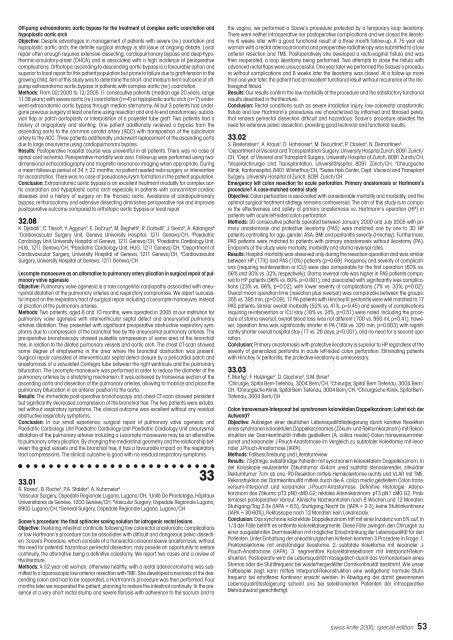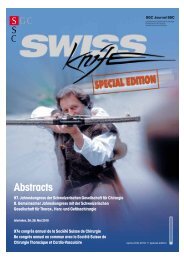Abstracts 4. Gemeinsamer Jahreskongress der ... - SWISS KNIFE
Abstracts 4. Gemeinsamer Jahreskongress der ... - SWISS KNIFE
Abstracts 4. Gemeinsamer Jahreskongress der ... - SWISS KNIFE
Create successful ePaper yourself
Turn your PDF publications into a flip-book with our unique Google optimized e-Paper software.
swissknife spezial 06 12.06.2006 13:39 Uhr Seite 53<br />
Off-pump extraanatomic aortic bypass for the treatment of complex aortic coarctation and<br />
hypoplastic aortic arch<br />
Objective: Despite advantages in management of patients with severe (re-) coartation and<br />
hypoplastic aortic arch, the definite surgical strategy is still issue of ongoing debate. Local<br />
repair often enough requires extensive dissecting, cardiopulmonary bypass and deep-hypothermic-circulatory-arrest<br />
(DHCA) and is associated with a high incidence of perioperative<br />
complications. Orthotopic ascending-to-descending aortic bypass is a favourable option and<br />
superior to local repair for this patient population but prone to failure due to graft-tension in the<br />
growing child. Aim of this study was to determine the short- and medium-term outcome of offpump<br />
extraanatomic aortic bypass in patients with complex aortic (re-) coarctation.<br />
Methods: From 02/2000 to 12/2005 11 consecutive patients (median age 20 years, range<br />
11-38 years) with severe aortic (re-) coarctation (n=4) or hypoplastic aortic arch (n=7) un<strong>der</strong>went<br />
extraanatomic aortic bypass through median sternotomy. All but 3 patients had un<strong>der</strong>gone<br />
previous surgery at least one time using resection and end-to-end anastomosis, subclavian<br />
flap or patch aortoplasty or interposition of a polyester tube graft. Two patients had a<br />
history of angioplasty and stenting. One patient additionally received a bypass from the<br />
ascending aorta to the common carotid artery (ACC) with transposition of the subclavian<br />
artery to the ACC. Three patients additionally un<strong>der</strong>went replacement of the ascending aorta<br />
due to large aneurysms using cardiopulmonary bypass.<br />
Results: Postoperative hospital course was uneventful in all patients. There was no case of<br />
spinal cord ischemia. Perioperative mortality was zero. Follow-up was performed using twodimensional<br />
echocardiography and magnetic-resonance imaging when appropriate. During<br />
a mean follow-up period of 34 ± 22 months, no patient needed redo-surgery or intervention<br />
for recoarctation. There was no case of pseudoaneurysm formation in the patient population.<br />
Conclusion: Extraanatomic aortic bypass is an excellent treatment modality for complex aortic<br />
coarctation and hypoplastic aortic arch especially in patients with concomitant cardiac<br />
diseases and a history of surgery on the thoracic aorta. Avoidance of cardiopulmonary<br />
bypass, re-thoracotomy and extensive dissecting diminishes perioperative risk and improves<br />
postoperative outcome compared to orthotopic aortic bypass or local repair.<br />
32.08<br />
K. Djebaili 1 , C. Tissot 2 , Y. Aggoun 3 , E. DaCruz 4 , M. Beghetti 3 , R. Corbelli 3 , J. Sierra 5 , A. Kalangos 6<br />
1 Cardiovascular Surgery Unit, Geneva University Hospital, 1211 Geneva/CH, 2 Paediatric<br />
Cardiology Unit, University Hospital of Geneva, 1211 Geneva/CH, 3 Paediatric Cardiology Unit,<br />
HUG, 1211 Geneva/CH, 4 Paediatric Cardiology Unit, HUG, 1211 Geneva/CH, 5 Department of<br />
Cardiovascular Surgery, University Hospital of Geneva, 1211 Geneva/CH, 6 Cardiovascular<br />
Surgery, University Hospital of Geneva, 1211 Geneva/CH<br />
Lecompte manoeuvre as an alternative to pulmonary artery plication in surgical repair of pulmonary<br />
valve agenesia<br />
Objective: Pulmonary valve agenesia is a rare congenital cardiopathy associated with aneurysmal<br />
dilatation of the pulmonary arteries and respiratory compromise. We report successful<br />
impact on the respiratory tract of surgical repair including a Lecompte manoeuvre, instead<br />
of plication of the pulmonary arteries.<br />
Methods: Two patients, aged 6 and 10 months, were operated in 2005 at our institution for<br />
pulmonary valve agenesia with interventricular septal defect and aneurysmal pulmonary<br />
arteries dilatation. They presented with significant preoperative obstructive respiratory symptoms<br />
due to compression of the bronchial tree by the aneurysmal pulmonary arteries. The<br />
pre-operative bronchoscopy showed pulsatile compression of some area of the bronchial<br />
tree, in relation to the dilated pulmonary vessels and aortic arch. The chest CT-scan showed<br />
some degree of emphysema in the area where the bronchial obstruction was present.<br />
Surgical repair consisted of interventricular septal defect closure by a pericardial patch and<br />
anastomosis of a valvulated Contegra tube between the right ventricule and the pulmonary<br />
bifurcation. The Lecompte manoeuvre was performed in or<strong>der</strong> to reduce the diameter of the<br />
pulmonary arteries by a stretching mechanism. It was achieved by transverse section of the<br />
ascending aorta and dissection of the pulmonary arteries, allowing to mobilize and place the<br />
pulmonary bifurcation in an anterior position to the aorta.<br />
Results: The immediate post-operative bronchoscopy and chest CT-scan showed persistent<br />
but significantly decreased compression of the bronchial tree. The two patients were extubated<br />
without respiratory symptoms. The clinical outcome was excellent without any residual<br />
obstructive respiratory symptoms.<br />
Conclusion: In our small experience, surgical repair of pulmonary valve agenesia and<br />
Paediatric Cardiology Unit Paediatric Cardiology Unit Paediatric Cardiology Unit aneurysmal<br />
dilatation of the pulmonary arteries including a Lecompte manoeuvre may be an alternative<br />
to pulmonary artery plication. By changing the mediastinal geometry and the relationship between<br />
the great vessels and the bronchial tree, it has a favourable impact on the respiratory<br />
tract compressions. The clinical outcome is good with no residual respiratory symptoms.<br />
33<br />
33.01<br />
R. Rosso 1 , B. Roche 2 , P.A. Stal<strong>der</strong> 3 , A. Kuhrmeier 4<br />
1 Vascular Surgery, Ospedale Regionale Lugano, Lugano/CH, 2 Unité De Proctologie, Hôpitaux<br />
Universitaires de Genève, 1200 Genève/CH, 3 Vascular Surgery, Ospedale Regionale Lugano,<br />
6900 Lugano/CH, 4 General Surgery, Ospedale Regionale Lugano, Lugano/CH<br />
Soave’s procedure: the final sphincter saving solution for iatrogenic rectal lesions<br />
Objective: Restoring intestinal continuity following low colorectal anastomotic complications<br />
or low Hartmann’s procedure can be associates with difficult and dangerous pelvic dissection.<br />
Soave's Procedure, which consists of a transrectal coloanal sleeve anastomosis, without<br />
the need for potential hazardous perirectal dissection, may provide an opportunity to restore<br />
continuity, the alternative being a definitive colostomy. We report two cases and a review of<br />
the literature.<br />
Methods: A 52 year old woman, otherwise healthy, with a rectal adenocarcinoma was submitted<br />
to a laparoscopic low anterior resection with TME. She developed a necrosis of the descending<br />
colon and had to be reoperated, a Hartmann’s procedure was then performed. Four<br />
months later we reoperated the patient, planning to restore the intestinal continuity. In the presence<br />
of a very short rectal stump and severe fibrosis with adherence to the sacrum and to<br />
the vagina, we performed a Soave’s procedure protected by a temporary loop ileostomy.<br />
There were neither intraoperative nor postoperative complications and we closed the ileostomy<br />
6 weeks later with a good functional result at a three month follow-up. A 75 year old<br />
woman with a rectal adenocarcinoma and preoperative radiotherapy was submitted to a low<br />
anterior resection and TME. Postoperatively she developed a recto-vaginal fistula and was<br />
then reoperated, a loop ileostomy being performed. Two attempts to close the fistula with<br />
advanced rectal flaps were unsuccessful. One year later we performed the Soaves’s procedure<br />
without complications and 8 weeks later the ileostomy was closed. At a follow-up more<br />
than one year later, the patient had an excellent functional result without recurrence of the rectovaginal<br />
fistula.<br />
Results: Our results confirm the low morbidity of the procedure and the satisfactory functional<br />
results described in the literature.<br />
Conclusion: Rectal conditions such as severe irradiation injury, low colorectal anastomotic<br />
fistula and low Hartmann’s procedures are characterized by inflamed and fibrosed pelvis,<br />
that ren<strong>der</strong>s perirectal dissection difficult and hazardous. Soave’s procedure obviates the<br />
need for extensive pelvic dissection, providing good technical and functional results.<br />
33.02<br />
S. Breitenstein1 , A. Kraus2 , D. Hahnloser3 , M. Decurtins4 , P. Clavien5 , N. Demartines2 1Department of Visceral and Transplantation Surgery, University Hospital Zurich, 8091 Zurich/<br />
CH, 2Dept. of Visceral and Transplant Surgery, University Hospital of Zurich, 8091 Zurich/CH,<br />
3 4 Viszeralchirurgie Und Transplantation, Universitätsspital, 8091 Zürich/CH, Chirurgische<br />
Klinik, Kantonsspital, 8401 Winterthur/CH, 5Swiss Hpb Center, Dept. Visceral and Transplant<br />
Surgery, University Hospital of Zurich, 8091 Zurich/CH<br />
Emergency left colon resection for acute perforation. Primary anastomosis or Hartmann’s<br />
procedure? A case-matched control study<br />
Objective: Colon perforation is associated with consi<strong>der</strong>able mortality and morbidity, and the<br />
optimal surgical treatment strategy remains controversial. The aim of this study is to compare<br />
the effectiveness and safety of primary anastomosis vs. Hartmann’s operation (HP) in<br />
patients with acute left-sided colon perforation.<br />
Methods: 30 consecutive patients operated between January 2000 and July 2005 with primary<br />
anastomosis and protective ileostomy (PAS) were matched one by one to 30 HP<br />
patients controlling for age, gen<strong>der</strong>, ASA, BMI and peritonitis severity (Hinchey). Furthermore,<br />
PAS patients were matched to patients with primary anastomosis without ileostomy (PA).<br />
Endpoints of the study were mortality, morbidity and stoma reversal rates.<br />
Results: Hospital mortality was observed only during the resection-operation and was similar<br />
between HP (17%) and PAS (10%) patients (p=0.69). Frequency and severity of complications<br />
(requiring re-intervention or ICU) were also comparable for the first operation (60% vs.<br />
56% and 30% vs. 32%, respectively). Stoma reversal rate was higher in PAS patients compared<br />
to HP patients (96% vs. 60%, p=0.001), and associated with significantly less complications<br />
(23% vs. 66%, p=0.02), with lower severity of complications (7% vs. 33%, p=0.02).<br />
Overall mean operation time (resection plus reversal) was comparable between the groups:<br />
355 vs. 395 min, (p=0.09). 17 PA patients with Hinchey III peritonitis were well matched to 17<br />
PAS patients. Similar overall morbidity (52% vs. 41%, p=0.45) and severity of complications<br />
requiring re-intervention or ICU stay (18% vs. 24%, p=0.51) were noted. Including the procedure<br />
of stoma reversal, overall blood loss was not different (700 vs. 950 ml, p=0.41), however,<br />
operation time was significantly shorter in PA (169 vs. 320 min, p=0.003) with significantly<br />
shorter overall hospital stay (17 vs. 28 days, p
















